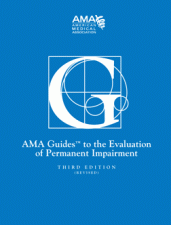
One of the questions I hear frequently about the Colorado workers’ compensation system from risk managers, insurance adjusters, and even some medical professionals is: “Why does Colorado still use the AMA Guides Third Edition, Revised, when calculating impairment?” In other words, why do Division Level II accredited physicians providing impairment ratings to injured workers use the AMA Guides to the Evaluation of Permanent Impairment, Third Edition, Revised (December 1990)? As of 2002, Colorado was, and still is, the only jurisdiction to use the Third Edition in the workers’ compensation system.[1]
The Third Revised Edition’s history in the Colorado workers’ compensation system is simple. The Colorado Workers’ Compensation Act underwent an extensive remodel in 1991. In the 1991 Amendments to the Act, the legislature inserted in section 8-42-107(A)(c), C.R.S., the methods to calculate impairment. In order to establish the medical impairment value for purposes of a permanent partial disability award, the legislature adopted the Third Edition, Revised (December 1990), which, at the time, was state of the art. Since 1991, the legislature has not altered the statutory language.
The State of Colorado has arguably been cognizant of the fact it is the only state in the nation to hold onto this antiquated edition. In fact, the Colorado Department of Labor and Employment commissioned a study in 2002, concluding that “spinal impairment evaluations are the most frequent type of evaluations performed.”[2] The study stated that, amongst the guides, there are significant differences in spinal impairment. The author pointed out “the impairment estimate for a spinal injury may be quite different depending on which edition is used to rate the condition.” The author concluded “Values were significantly less with both the Fourth and Fifth Editions, although more dramatically with the Fourth Edition.” The study pointed to different range of motion calculations between the guides to explain the discrepancy.
Per its own commissioned study that the use of the Third Edition Revised results in higher impairment ratings, and, therefore, higher permanent partial disability awards, Colorado has held strong to the Third Revised Edition. In 2007 the AMA Guides Sixth Edition was published. The more recent studies show a decrease in impairment ratings with the Sixth Edition when compared to ratings under the Fifth Edition.[3] The State of Colorado utilizes the medical impairment rating system that on average provides the highest degree of impairment, including spinal impairments, to injured workers. It does not appear that there is any legislative progress to bring Colorado into alignment with any other state anytime soon. Which begs the final question: Colorado, what are you doing?
________________________________________________________________________________
[1] Study of the Impact on Changing from the American Medical Association (AMA) Guides to the Evaluation of Permanent Impairment, Third Edition Revised to the Fourth or Fifth Editions in Determining Workers’ Compensation Impairment Ratings, Christopher Brigham, M.D. (June 30, 2002).
[2] Id. 58.
[3] Impact on Impairment Ratings from the American Medical Association’s Sixth Edition of the Guides to the Evaluation of Permanent Impairment, Robert Moss, et. al. (July 2012) at 25.





